 The Next Crash - Part I: How the First Bounce of the Debt Deflation Bear Market ends
The Next Crash - Part I: How the First Bounce of the Debt Deflation Bear Market endsThe First Bounce of the Debt Deflation Bear Market has gone on for four months longer than we expected. Will it end with a down-for-the-count crash or a correction followed by quick recovery? What will end it? Rate hikes by the Fed? The escalating sovereign debt crisis in Europe? A banking and financial crisis in China’s credit bubble economy? The next Peak Cheap Oil recession? Our answer: All of them, and pretty much all at once. If you thought the 2008 crash was bad, wait until you see the next one.
• Europe's overdue debt crisis
• Goldman pig pile
• Skipping the round trip in stocks
CI: Until yesterday it was DOW 11,000 party hats time again. Your December 10, 2009 “Asylum Markets of the post FIRE Economy – Part II: The Next Recession” said, “The stock market will revert to the mean after an external event, most likely a sovereign debt default.” That article makes an interesting read given events in Europe and the stock markets the past two days, even the part about gold rising as stocks fall, “... as a form of flight capital in response to this risk,” you said.
EJ: When the capital is fleeing both Europe and the United States, flight capital has to be denominated in something. If not euros or dollars, then the fourth currency. Before yesterday, anyone who rode out the Debt Deflation Bear Market through 2008 and early 2009, life had to feel much better than in February 2009 when the stock market was down 47% from December 2007 when we got out. Even after yesterday’s bad day, the markets are only down 17% nominally and 20% in CPI adjusted terms, if you believe the CPI is a valid measure of inflation, which it is not. In any case, the average buy-and-hold stock market investor thinks in nominal terms and must feel close to vindicated for riding it out, at least until yesterday. But most investors remain nervous, and that’s why we got the strong reaction to the latest escalation of the Old Europe debt crisis.
CI: Is this it, the big one?
EJ: I’m not ready to say “Time to short” it yet, but the fix is in. The consensus is usually wrong, but in this case it’s so obvious that even the average wealth manager gets it. For example, a wealth manager who works for one of the big investment banks recently counseled a friend that his firm couldn’t beat the risk-adjusted returns he was getting on his current CD holdings earning 1.5% over the next 18 to 24 months. In fact, I can’t find anyone in the professional investment community who doesn’t expect a major fallout from the extraction of monetary and government supports that hammers stocks and bonds. A friend in the hedge fund industry who has been consistently correct with his generally optimistic assessment of the stock market since March 2009 sees the rally that we call the "First Bounce" ending n the Autumn. He colorfully describes the events that are likely to cause the correction as a “shit show.”
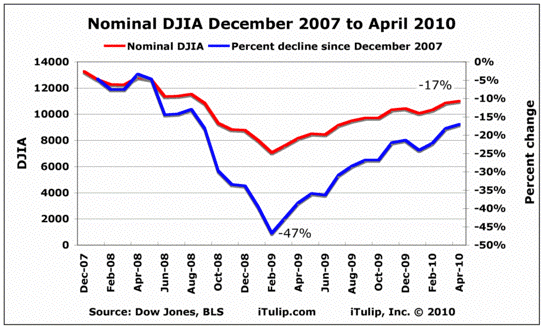
First Bounce Nominal
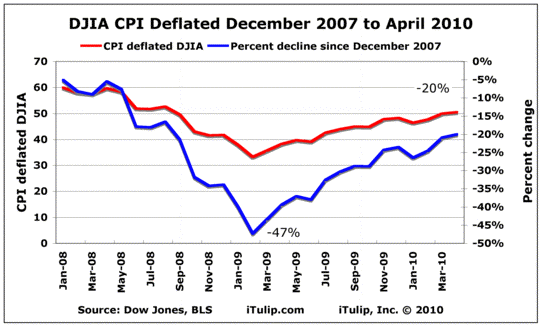
First Bounce CPI adjusted
CI: Remind readers what the Debt Deflation Bear Market is.
EJ: It is the negative reaction of the stock market to cycles of economic contraction and growth that result from policy shifts toward and away from zero interest rate monetary policy (ZIRP) and deficit spending to alternately ward off inflation and maintain expansions after an over-indebted economy crashes. Our models are Japan after 1990 and the United States after 1929 and 2000, but brought up to date.
The first year was predictable, at least to us, with stocks falling 40% in 2008 as we forecast at the end of 2007 (see Time at last to short the market, Dec. 27, 2007). The next step in the process, reflation via monetary and fiscal policy, and bank rescues via loans and purchases of bad debts and unmarketable assets, was also predictable and forecast as a Debt Deflation Bear Market First Bounce. We did not believe that a prolonged period of deflation was in the cards, and we were right. Stock and commodity prices didn’t plunge for years as they did in the 1930s but only for four months in a brief period of deflation we call disinflation, just as we forecast. But, after that, the markets are driven by unpredictable political decisions. Anyone who tells you precisely what’s going to happen and when from here is full of it—including me when I told you I thought the First Bounce was due to end before the end of 2009. I won’t do that again. But I can give you my opinion on the dominant underlying processes and the likely scenarios.
CI: Is the First Bounce over?
EJ: Anything can happen to derail the recovery process that stock market investors come to view as sustainable, even though government continues to influence the recovery in many respects. The data show that the recovery is picking up steam at this point not losing it, and the analysis we show in Part II portray a run-of-the-mill recovery, consistent with our forecasts from December 2009, and we compare forecasts then to actual data today. That said, there are many oddities in the data. Also, the overall context of the recovery has been lost in most of the recovery stories I read. So before we go further, let’s get our bearings. Most of the discussions of the topic of the recovery lack context, just as the Housing Bubble Recession was discussed out of context when it happened.
First, let’s remember that we didn’t just go through a garden variety recession caused by the Fed raising rates to reign in one of the two forms of inflation that occur in a modern economy, either commodity price inflation in the Production/Consumption Economy or asset price inflation in the FIRE Economy.
We live in a post-bubble hangover economy. It’s not like the 1990s or early 2000s recovery or any other. It’s unique, as are the threats to its recovery that are itemized in the opening of this article: future rate hikes by the Fed, the escalating sovereign debt crisis in Europe, a banking and financial crisis in China’s credit bubble economy, and the next Peak Cheap Oil Cycle recession. Complicating matters, there are inter-dependencies. For example, a second recession triggered by a sovereign debt crisis may forestall the next Peak Cheap Oil Cycle by again reducing oil demand worldwide as occurred in 2008 and 2009.
EJ: It is the negative reaction of the stock market to cycles of economic contraction and growth that result from policy shifts toward and away from zero interest rate monetary policy (ZIRP) and deficit spending to alternately ward off inflation and maintain expansions after an over-indebted economy crashes. Our models are Japan after 1990 and the United States after 1929 and 2000, but brought up to date.
The first year was predictable, at least to us, with stocks falling 40% in 2008 as we forecast at the end of 2007 (see Time at last to short the market, Dec. 27, 2007). The next step in the process, reflation via monetary and fiscal policy, and bank rescues via loans and purchases of bad debts and unmarketable assets, was also predictable and forecast as a Debt Deflation Bear Market First Bounce. We did not believe that a prolonged period of deflation was in the cards, and we were right. Stock and commodity prices didn’t plunge for years as they did in the 1930s but only for four months in a brief period of deflation we call disinflation, just as we forecast. But, after that, the markets are driven by unpredictable political decisions. Anyone who tells you precisely what’s going to happen and when from here is full of it—including me when I told you I thought the First Bounce was due to end before the end of 2009. I won’t do that again. But I can give you my opinion on the dominant underlying processes and the likely scenarios.
CI: Is the First Bounce over?
EJ: Anything can happen to derail the recovery process that stock market investors come to view as sustainable, even though government continues to influence the recovery in many respects. The data show that the recovery is picking up steam at this point not losing it, and the analysis we show in Part II portray a run-of-the-mill recovery, consistent with our forecasts from December 2009, and we compare forecasts then to actual data today. That said, there are many oddities in the data. Also, the overall context of the recovery has been lost in most of the recovery stories I read. So before we go further, let’s get our bearings. Most of the discussions of the topic of the recovery lack context, just as the Housing Bubble Recession was discussed out of context when it happened.
First, let’s remember that we didn’t just go through a garden variety recession caused by the Fed raising rates to reign in one of the two forms of inflation that occur in a modern economy, either commodity price inflation in the Production/Consumption Economy or asset price inflation in the FIRE Economy.
We live in a post-bubble hangover economy. It’s not like the 1990s or early 2000s recovery or any other. It’s unique, as are the threats to its recovery that are itemized in the opening of this article: future rate hikes by the Fed, the escalating sovereign debt crisis in Europe, a banking and financial crisis in China’s credit bubble economy, and the next Peak Cheap Oil Cycle recession. Complicating matters, there are inter-dependencies. For example, a second recession triggered by a sovereign debt crisis may forestall the next Peak Cheap Oil Cycle by again reducing oil demand worldwide as occurred in 2008 and 2009.
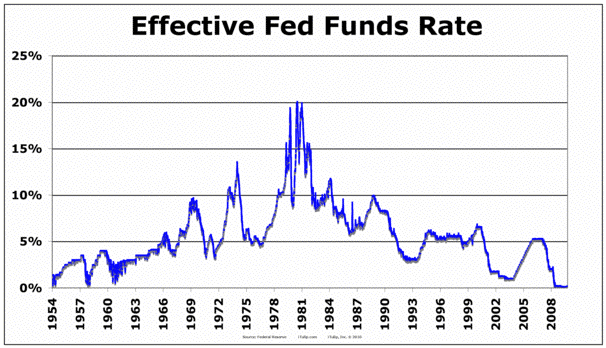
Fed Funds rate lowest, longest--ever
Short-term rates set by the Fed are still zero, for all practical purposes, and have been since December 2008. That’s easy to forget that because no one talks about it anymore. It's like the wallpaper in your bedroom at this point. It's just there, and no one notices. But it’s never happened before in the United States except for very brief emergency periods of a month or two.
We’re supposed to believe that the reason for the extended ultra low rates today is to “stimulate the economy” by making credit cheap for businesses and consumers. Actually, that’s how the private sector got into the position of over-indebtedness in the first place, by the Fed making credit too cheap relative to incomes both directly via rate cuts and indirectly by implicitly guaranteeing bad loans made by banks to households. Today’s near zero short-term rate policy remains in place because the economy is so fully loaned up that it cannot operate if interest expenses rise. The demand on cash flow to pay interest will choke off the recovery. We are, like the Japanese, stuck.
CI: I want to stop you a minute. Was there ever a time when interest rates adjusted automatically?
EJ: That’s an excellent question. How were interest rates set before the era of central banks? Greenspan in the early days of running the Fed used to lament the loss of the automaticity of interest rate adjustments under the gold standard; interest rates adjusted upward automatically when depositors withdrew gold deposits in response to the perception that banks were over-extended and lending too carelessly. Loose lending showed up as an increase in defaults, rising inflation, or both. In response to the gold reserve withdrawals the banks had to raise rates to attract deposits back, to compensate depositors for the added default and inflation risk. The higher rates in turn reduced lending activity and brought both non-performing loans and inflation back into line. It was a stable system for hundreds of years, except when governments interfered through the credit markets outside the banking system as in the 1860s and 1920s in the United States.
Getting back to the context for the recovery, besides ultra-low short-term interest rates, government spending net of tax collections has never been higher.
We’re supposed to believe that the reason for the extended ultra low rates today is to “stimulate the economy” by making credit cheap for businesses and consumers. Actually, that’s how the private sector got into the position of over-indebtedness in the first place, by the Fed making credit too cheap relative to incomes both directly via rate cuts and indirectly by implicitly guaranteeing bad loans made by banks to households. Today’s near zero short-term rate policy remains in place because the economy is so fully loaned up that it cannot operate if interest expenses rise. The demand on cash flow to pay interest will choke off the recovery. We are, like the Japanese, stuck.
CI: I want to stop you a minute. Was there ever a time when interest rates adjusted automatically?
EJ: That’s an excellent question. How were interest rates set before the era of central banks? Greenspan in the early days of running the Fed used to lament the loss of the automaticity of interest rate adjustments under the gold standard; interest rates adjusted upward automatically when depositors withdrew gold deposits in response to the perception that banks were over-extended and lending too carelessly. Loose lending showed up as an increase in defaults, rising inflation, or both. In response to the gold reserve withdrawals the banks had to raise rates to attract deposits back, to compensate depositors for the added default and inflation risk. The higher rates in turn reduced lending activity and brought both non-performing loans and inflation back into line. It was a stable system for hundreds of years, except when governments interfered through the credit markets outside the banking system as in the 1860s and 1920s in the United States.
Getting back to the context for the recovery, besides ultra-low short-term interest rates, government spending net of tax collections has never been higher.
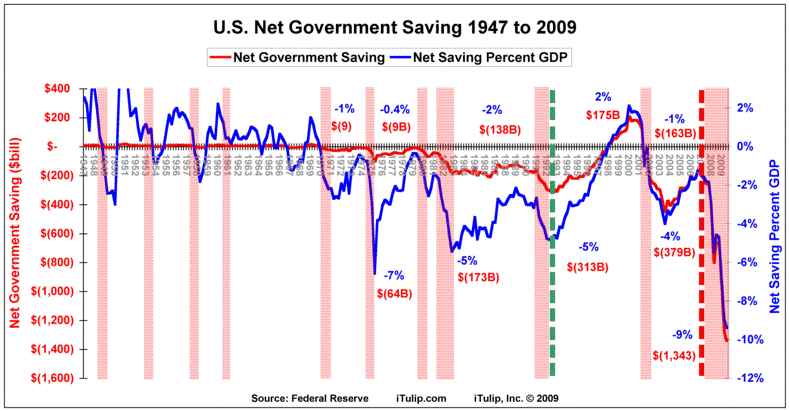
The difference between outlays and revenues is government saving.
Net dis-saving reached -9% of GDP in 2009.
The other antecedent to recovery to keep in mind is government spending. We’re not supposed to worry about this because we’re going to grow our way out of it, but try to imagine what might happen if the next recession occurs before tax receipts recover to previous levels while government outlays are cut. We think it might go something like this.
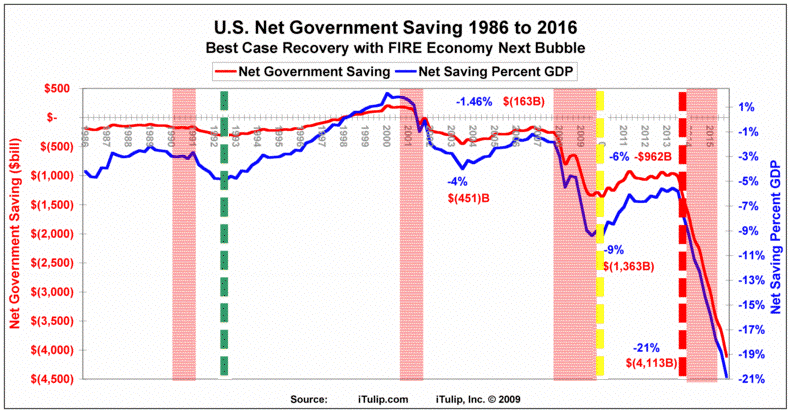
Might deficit spending to stimulate the economy in a next recession
produce a $4 trillion shortfall, or 21% of GDP?
Those are the antecedents and the implications. We can’t afford another recession anytime soon, but we are likely to get one anyway, in our opinion around 2013, after the next US Presidential election.
CI: Let’s go back to your article on March 27, 2009 at the height of the panic. When others were calling for an extended period of deflation, you forecast a Debt Deflation Bear Market First Bounce. I’ll quote from it:
EJ: Just as a market driven market crash is process not an event, not an event, a government financed reflation rally within a Debt Deflation Bear Market is a process, too. And a long one--ask the Japanese. The first bounce of ours one started with the brave leaders crawling out of the crater, buying stocks in March 2009. They were followed by fund managers that summer who could not afford to be left out as the market recovered. The crisis headlines subsided as trillions of stimulus and bailout money rescued the banks and started to lift the economy. Stock prices went up, and more and more investors got back in. We had a brief setback with the first signs of the PIIGS debt crisis this winter, and everyone thought the problem had gone away after the leading edge of it in Greece was reported alternately as solved and not solved several times. Market sentiment, increasingly positive economic data such as retail sales and unemployment, and rising stock prices themselves, boosted sentiment that in turn pushed the markets higher in a wave of increasing confidence. This confidence was informed by past experience. Jeremy Grantham astutely labeled it “the last hurrah” in a private presentation I saw him give a few months ago, hosted by UBS.
In periods of inflation such as we have been in since 2001, talking about market price levels over multi-year periods is tricky. For example, DJIA 10,000 in 2010 is roughly equivalent to DJIA 6,000 in 2000, yet everyone seems perfectly happy to celebrate DJIA 10,000 now as if it were some kind of achievement when in fact it represents a 40% loss in real market value over ten years. So how shall I talk about another 50% loss over the next ten years? Shall I forecast DJIA 10,000 and explain each time that I mean DJIA 5,000 in 2010 dollars, or shall I talk about DJIA 5,000 in which case when the market is trading around 10,000 it appears that the forecast is off by 50%? It's a conundrum that I have yet to solve.
CI: Do you regret not getting back in back into the stock market in March 2009?
EJ: No. We skipped the trip from 2007 completely, as of today leaving us 20% ahead of the game in real terms. In fact, readers who have been hanging around here since March 2000 have skipped the trip from NASDAQ 5000 to 2500 today and S&P500 1500 ten years ago to 2200 today. Now, if you got out in December 2007 with us but then got back in March 2009, then you’re a genius—unless of course the market crashes again.
CI: Like yesterday...
EJ: That was a just a speed bump. What is more interesting is the rise in volatility after a long period of quiet.
CI: Are investors starting to question the durability of the recovery, or is the market starting to look into the next recession?
EJ: The question is not whether spending a few trillion dollars will get an economy going again. We can see that in the data. Look at it this way. Imagine you’re deeply in debt and you’ve lost your job and your wife has, too, and you have 300 million kids and piles of bills to pay. You’re like the USA. What to do? Well, you can stop paying your bills, which will make your creditors unhappy and cause them to raise interest rates on you and further slow your cash flow. You can cut your expenses, which makes millions of your family members unhappy. You can beg and threaten friends and relatives for money to cover short-term expenses while you find a new job. But that’s about it. But not when you are a country, and especially not when you are the world’s largest economy with hundreds of military bases all over the planet keeping the oil flowing and a lid on factions that are not chummy with your oil suppliers. Also, you owe all of your friends and relatives so much money that if you either default or inflate that debt away they’ll all collectively go into an economic and political nosedive. In that case you have an emergency credit card. You can use it to borrow even more money from friends and relatives and print money yourself to tide you over until you and the wife and the kids find new jobs, and soon enough the family is in the black again. Everything is rosy and going in the right direction, except now you have even more debt than before. Imagine having that emergency credit card that you can pull out in a pinch to cover everything until you are back on your feet. That’s what the United States has. Problem is, we’ve used the card one time too many. Asylum Markets investigates what might happen if the United States finds itself facing a fresh recession in 2013, triggered by a sovereign debt crisis or the next Peak Cheap Oil Cycle, among the most likely causes.
So while most economic indicators are pointing to growth there remains this nagging problem of where the economic surplus will come from, and in the short run whether the money that is financing the short-term loans will keep coming in if China has a crisis, and whether the old loans can be rolled over as they come due. So, on the surface, a post-bubble recovery looks like any other, but under the surface the problems that led to the crisis remain as acute as ever.
CI: Last year you identified a European sovereign debt crisis as the most likely source of the next crash. What’s going on in Europe?
EJ: As in the case of the private credit markets crisis in the United States that began in 2007, the sovereign debt crisis in Europe that began in Greece has been brewing for decades.
CI: Is this Europe’s version of “the subprime crisis is contained”?
EJ: The dynamics are entirely different. The concept of containment and contagion makes sense in the context of a private credit markets crisis, such as from low quality, high risk debt in the market for subprime loans in the United States infecting higher quality, lower risk debt. Think instead of escalation not contagion, because the process of a sovereign debt crisis is a political process not a market process. Before I go on I want to make sure that readers know what the term “sovereign debt” means. It means the government debt of sovereign states, as compared to bonds issued by local governments, municipalities, prefectures, and so on. I should also talk briefly about my sources. Two are Greek. One now runs a few billion of private equity but as a youth ran through the streets of Athens throwing Molotov cocktails at the riot police that represented the dictatorship there at the time, which protests were ultimately successful in ending the dictatorship there.
The government there has not been as much improved as one might hope, and the ruling elite that took over did maintain certain advantages as before, such as not paying taxes. Tax revenues thus not being sufficient to maintain infrastructure and other social amenities at the level expected by the Greeks as European citizens, the difference needed to finance the lifestyle to which voters had become accustomed was borrowed abroad. Thing is, every German and Frenchman and other European has been perfectly aware of this forever. The French and Germans are famous for levying hefty taxes on any large moving financial object. The ruling elites are heavily taxed to the point where it is practically illegal to be as rich as, say, Warren Buffett or Bill Gates. Thus, when the European debt crisis eventually arrived, triggered by the US mortgage credit crisis, ironically, the Germans and French were in no mood to send money to Greece’s ruling elite to save their bacon, and still aren’t. Faced with a threat to its credit rating, rather than change the tax laws to tax themselves and end the fiscal crisis that is at the bottom of the PIIGS debt crisis, the Greek leadership instead decided to cut expenses and impose “austerity,” that is, extract even more from the Greek middle class, such as it is. That didn’t go over so well with voters, and soon the Greeks were out on the streets as my friend was so many years ago. It’s a tradition there that does not exist here.
CI: What about the IMF?
EJ: After several months of public bickering with Germany, the IMF showed up. Then the shit really hit the fan. The Greeks, it turns out, can read. And what they read about the past behavior of the IMF in Latin America and Asia and everywhere else they’ve shown up to “rescue” a country in debt is a 100% consistent record of bailing out the ruling elite while imposing austerity on everyone else and leaving the country even more indebted than before. The Greek people are not buying the line, "We're the IMF and we're here to help you."
So now we have an impasse. Germany and other European countries with progressive tax regimes refuse the bail out the Greeks whose people refuse to accept further cuts in jobs and services for the benefit of their ruling elite.
CI: How does it end?
EJ: I don't see how it ends well. The thing to remember is that when things go to hell in a sovereign debt crisis, they go the hell in a hurry. The process is escalation, de-escalation, further escalation, then de-escalation. Finally, one fine day a payment has to be made that can't be made and creditors throw in the towel even if it means taking a huge loss. Here’s what happened to bond prices when the IMF threw in the towel on Argentina in 2001.
CI: Let’s go back to your article on March 27, 2009 at the height of the panic. When others were calling for an extended period of deflation, you forecast a Debt Deflation Bear Market First Bounce. I’ll quote from it:
"In a recession, a recovery in personal consumption, incomes, and retail sales signals the start of recovery. The virtuous cycle of credit growth--and its corollary, debt growth—combine with rising incomes as the rate of unemployment growth slows. Credit expansion leads the economy out of the cycle, followed by incomes. That is what many stock market participants think they are seeing now, as previous experience has trained them to see. But they are wrong."
That turned out to be accurate. But later you go on to forecast the DJIA falling back to 5,000.EJ: Just as a market driven market crash is process not an event, not an event, a government financed reflation rally within a Debt Deflation Bear Market is a process, too. And a long one--ask the Japanese. The first bounce of ours one started with the brave leaders crawling out of the crater, buying stocks in March 2009. They were followed by fund managers that summer who could not afford to be left out as the market recovered. The crisis headlines subsided as trillions of stimulus and bailout money rescued the banks and started to lift the economy. Stock prices went up, and more and more investors got back in. We had a brief setback with the first signs of the PIIGS debt crisis this winter, and everyone thought the problem had gone away after the leading edge of it in Greece was reported alternately as solved and not solved several times. Market sentiment, increasingly positive economic data such as retail sales and unemployment, and rising stock prices themselves, boosted sentiment that in turn pushed the markets higher in a wave of increasing confidence. This confidence was informed by past experience. Jeremy Grantham astutely labeled it “the last hurrah” in a private presentation I saw him give a few months ago, hosted by UBS.
In periods of inflation such as we have been in since 2001, talking about market price levels over multi-year periods is tricky. For example, DJIA 10,000 in 2010 is roughly equivalent to DJIA 6,000 in 2000, yet everyone seems perfectly happy to celebrate DJIA 10,000 now as if it were some kind of achievement when in fact it represents a 40% loss in real market value over ten years. So how shall I talk about another 50% loss over the next ten years? Shall I forecast DJIA 10,000 and explain each time that I mean DJIA 5,000 in 2010 dollars, or shall I talk about DJIA 5,000 in which case when the market is trading around 10,000 it appears that the forecast is off by 50%? It's a conundrum that I have yet to solve.
CI: Do you regret not getting back in back into the stock market in March 2009?
EJ: No. We skipped the trip from 2007 completely, as of today leaving us 20% ahead of the game in real terms. In fact, readers who have been hanging around here since March 2000 have skipped the trip from NASDAQ 5000 to 2500 today and S&P500 1500 ten years ago to 2200 today. Now, if you got out in December 2007 with us but then got back in March 2009, then you’re a genius—unless of course the market crashes again.
CI: Like yesterday...
EJ: That was a just a speed bump. What is more interesting is the rise in volatility after a long period of quiet.
CI: Are investors starting to question the durability of the recovery, or is the market starting to look into the next recession?
EJ: The question is not whether spending a few trillion dollars will get an economy going again. We can see that in the data. Look at it this way. Imagine you’re deeply in debt and you’ve lost your job and your wife has, too, and you have 300 million kids and piles of bills to pay. You’re like the USA. What to do? Well, you can stop paying your bills, which will make your creditors unhappy and cause them to raise interest rates on you and further slow your cash flow. You can cut your expenses, which makes millions of your family members unhappy. You can beg and threaten friends and relatives for money to cover short-term expenses while you find a new job. But that’s about it. But not when you are a country, and especially not when you are the world’s largest economy with hundreds of military bases all over the planet keeping the oil flowing and a lid on factions that are not chummy with your oil suppliers. Also, you owe all of your friends and relatives so much money that if you either default or inflate that debt away they’ll all collectively go into an economic and political nosedive. In that case you have an emergency credit card. You can use it to borrow even more money from friends and relatives and print money yourself to tide you over until you and the wife and the kids find new jobs, and soon enough the family is in the black again. Everything is rosy and going in the right direction, except now you have even more debt than before. Imagine having that emergency credit card that you can pull out in a pinch to cover everything until you are back on your feet. That’s what the United States has. Problem is, we’ve used the card one time too many. Asylum Markets investigates what might happen if the United States finds itself facing a fresh recession in 2013, triggered by a sovereign debt crisis or the next Peak Cheap Oil Cycle, among the most likely causes.
So while most economic indicators are pointing to growth there remains this nagging problem of where the economic surplus will come from, and in the short run whether the money that is financing the short-term loans will keep coming in if China has a crisis, and whether the old loans can be rolled over as they come due. So, on the surface, a post-bubble recovery looks like any other, but under the surface the problems that led to the crisis remain as acute as ever.
CI: Last year you identified a European sovereign debt crisis as the most likely source of the next crash. What’s going on in Europe?
EJ: As in the case of the private credit markets crisis in the United States that began in 2007, the sovereign debt crisis in Europe that began in Greece has been brewing for decades.
CI: Is this Europe’s version of “the subprime crisis is contained”?
EJ: The dynamics are entirely different. The concept of containment and contagion makes sense in the context of a private credit markets crisis, such as from low quality, high risk debt in the market for subprime loans in the United States infecting higher quality, lower risk debt. Think instead of escalation not contagion, because the process of a sovereign debt crisis is a political process not a market process. Before I go on I want to make sure that readers know what the term “sovereign debt” means. It means the government debt of sovereign states, as compared to bonds issued by local governments, municipalities, prefectures, and so on. I should also talk briefly about my sources. Two are Greek. One now runs a few billion of private equity but as a youth ran through the streets of Athens throwing Molotov cocktails at the riot police that represented the dictatorship there at the time, which protests were ultimately successful in ending the dictatorship there.
The government there has not been as much improved as one might hope, and the ruling elite that took over did maintain certain advantages as before, such as not paying taxes. Tax revenues thus not being sufficient to maintain infrastructure and other social amenities at the level expected by the Greeks as European citizens, the difference needed to finance the lifestyle to which voters had become accustomed was borrowed abroad. Thing is, every German and Frenchman and other European has been perfectly aware of this forever. The French and Germans are famous for levying hefty taxes on any large moving financial object. The ruling elites are heavily taxed to the point where it is practically illegal to be as rich as, say, Warren Buffett or Bill Gates. Thus, when the European debt crisis eventually arrived, triggered by the US mortgage credit crisis, ironically, the Germans and French were in no mood to send money to Greece’s ruling elite to save their bacon, and still aren’t. Faced with a threat to its credit rating, rather than change the tax laws to tax themselves and end the fiscal crisis that is at the bottom of the PIIGS debt crisis, the Greek leadership instead decided to cut expenses and impose “austerity,” that is, extract even more from the Greek middle class, such as it is. That didn’t go over so well with voters, and soon the Greeks were out on the streets as my friend was so many years ago. It’s a tradition there that does not exist here.
CI: What about the IMF?
EJ: After several months of public bickering with Germany, the IMF showed up. Then the shit really hit the fan. The Greeks, it turns out, can read. And what they read about the past behavior of the IMF in Latin America and Asia and everywhere else they’ve shown up to “rescue” a country in debt is a 100% consistent record of bailing out the ruling elite while imposing austerity on everyone else and leaving the country even more indebted than before. The Greek people are not buying the line, "We're the IMF and we're here to help you."
So now we have an impasse. Germany and other European countries with progressive tax regimes refuse the bail out the Greeks whose people refuse to accept further cuts in jobs and services for the benefit of their ruling elite.
CI: How does it end?
EJ: I don't see how it ends well. The thing to remember is that when things go to hell in a sovereign debt crisis, they go the hell in a hurry. The process is escalation, de-escalation, further escalation, then de-escalation. Finally, one fine day a payment has to be made that can't be made and creditors throw in the towel even if it means taking a huge loss. Here’s what happened to bond prices when the IMF threw in the towel on Argentina in 2001.
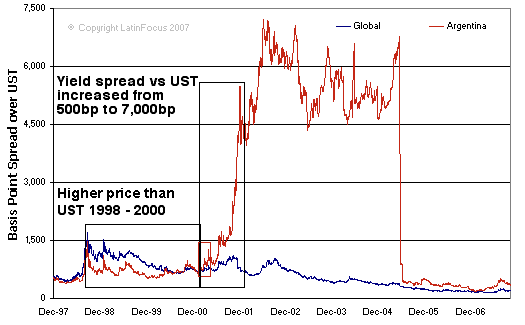
Currency peg ends badly for Argentina
CI: This explains why the euro is falling but not why the dollar is not rising while gold is rising.
EJ: I’ll answer that with a story.
 The Next Crash - Part II: Out of Gas ($ubscription)
The Next Crash - Part II: Out of Gas ($ubscription)
• Forecasts compared
• News reviewed
• Conclusions drawn
CI: If you were so sure in December 2009 that the economy was going to recover this way, in spite of the problems with the banks and consumer creditors, why didn’t you go back into the stock market at the time? It was trading 10% below where it is today.
EJ: You might as well ask me why I wasn’t buying houses in August 2002 when I forecast the housing bubble to last for several years or stocks in 2003 when I was forecasting a housing bubble fueled “recovery.” The recovery looks real enough today, just as the last one did from 2004 until the end of 2007, yet it’s just as unreal as then albeit in a different way. And what did I miss by staying out of the market the whole time, since 2000 when stocks peaked at levels that are still 40% above current levels in real terms? That was the time to buy commodities. Commodity prices have gone up more than three fold in real terms since then. Oil and just about anything else would have worked, but not commodity stocks. Perversely, Treasury bonds were the other buy then, and that’s the only other major holding we have, although it’s clearly time to start getting out of those. more...
iTulip Select: The Investment Thesis for the Next Cycle™
__________________________________________________
To receive the iTulip Newsletter or iTulip Alerts, Join our FREE Email Mailing List
Copyright © iTulip, Inc. 1998 - 2009 All Rights Reserved
All information provided "as is" for informational purposes only, not intended for trading purposes or advice. Nothing appearing on this website should be considered a recommendation to buy or to sell any security or related financial instrument. iTulip, Inc. is not liable for any informational errors, incompleteness, or delays, or for any actions taken in reliance on information contained herein. Full Disclaimer
EJ: I’ll answer that with a story.
 The Next Crash - Part II: Out of Gas ($ubscription)
The Next Crash - Part II: Out of Gas ($ubscription)• Forecasts compared
• News reviewed
• Conclusions drawn
CI: If you were so sure in December 2009 that the economy was going to recover this way, in spite of the problems with the banks and consumer creditors, why didn’t you go back into the stock market at the time? It was trading 10% below where it is today.
EJ: You might as well ask me why I wasn’t buying houses in August 2002 when I forecast the housing bubble to last for several years or stocks in 2003 when I was forecasting a housing bubble fueled “recovery.” The recovery looks real enough today, just as the last one did from 2004 until the end of 2007, yet it’s just as unreal as then albeit in a different way. And what did I miss by staying out of the market the whole time, since 2000 when stocks peaked at levels that are still 40% above current levels in real terms? That was the time to buy commodities. Commodity prices have gone up more than three fold in real terms since then. Oil and just about anything else would have worked, but not commodity stocks. Perversely, Treasury bonds were the other buy then, and that’s the only other major holding we have, although it’s clearly time to start getting out of those. more...
iTulip Select: The Investment Thesis for the Next Cycle™
__________________________________________________
To receive the iTulip Newsletter or iTulip Alerts, Join our FREE Email Mailing List
Copyright © iTulip, Inc. 1998 - 2009 All Rights Reserved
All information provided "as is" for informational purposes only, not intended for trading purposes or advice. Nothing appearing on this website should be considered a recommendation to buy or to sell any security or related financial instrument. iTulip, Inc. is not liable for any informational errors, incompleteness, or delays, or for any actions taken in reliance on information contained herein. Full Disclaimer

Comment